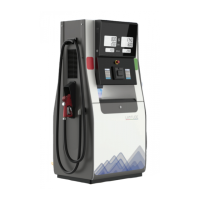
Do you have a question about the GILBARCO VEEDER-ROOT Latitude LS-100 and is the answer not in the manual?
| Model | Latitude LS-100 |
|---|---|
| Category | Petrol Station Equipment |
| Power Supply | 100-240 VAC, 50/60 Hz |
| Enclosure Rating | IP54 |
| Display | Touchscreen |
| Connectivity | Ethernet, Wi-Fi |
Document identifier for the manual.
Lists products certified by UL.
Lists products approved by CARB.
List of trademarks not officially registered.
Explains the manual's objective and scope.
Identifies the target audience for this manual.
Essential safety steps before operating or servicing.
Steps to take before initiating a service call.
General safety guidelines for equipment maintenance.
Guidelines for regular equipment inspections.
Contact details for technical assistance and support.
Defines the information covered in the manual.
List of related technical documents with their numbers.
Glossary of technical terms and their definitions.
Procedure for emergency power cutoff.
Explains safety alert symbols and signal words used.
Hazards and precautions when working with fuels and electricity.
Information on handling materials inside electronic enclosures.
Steps to provide information to emergency responders.
Critical safety warning regarding fuel hazards.
Document confirming compliance with EU directives.
Technical parameters of the dispenser.
Area with continuous presence of explosive atmosphere.
Area where explosive atmosphere may occur occasionally.
Area where explosive atmosphere is unlikely to occur.
Zoning for island configuration with high hose placement.
Zoning for island configuration with low hose placement.
Hazardous area zoning for specific 4-grade models.
Hazardous area zoning for models with hose retraction.
Crucial notes on material compatibility for dispenser use.
Overview of the Latitude dispenser and its main parts.
Diagram showing the front components of the dispenser.
Diagram showing the side components of the dispenser.
Description of the dispenser's keypad layout and functionality.
Functions that can be performed using the keypad.
Details about the dispenser's Liquid Crystal Display.
Details about the premium canopy features.
Information on skylight LED strips for image enhancement.
Explanation of the Vapor Recovery and Monitoring system.
Description of the hose retraction feature for easier fueling.
Information on the multimedia display feature of the dispenser.
Illustrates the operational workflow of the Latitude pump.
Describes the functioning steps of a self-contained pump.
Instructions for handling the fuel nozzle during fueling.
Steps to take before starting the fueling process.
Steps to follow after completing the fueling process.
Detailed instructions on how to fill a vehicle's tank.
Process for powering on and initializing the dispenser.
State of the dispenser after initialization.
Steps to start the fueling process.
How to set a predefined sale amount before fueling.
How to fuel without setting a predefined amount.
Accessing settings via the User Menu mode.
Accessing settings via the Command Code mode.
Action to open a sub-menu in User Menu mode.
Navigating to the TOTALIZER menu.
Commands typically used by station owners/operators.
Function code for setting available fueling point color.
Settings for comma and decimal points in displays.
Function code for money display decimal point settings.
Enables the Vapor Recovery and Monitoring system.
Menu for setting the date and time.
Menu for changing Price Per Unit.
Menu for viewing sales and volume totalizers.
Setting the dispenser to operate in standalone mode.
Steps to configure the pump using a USB drive.
Procedure to set the pump's configuration type.
Process for backing up configuration and logs to USB.
Actions to take before initiating service.
Tasks to perform prior to contacting service personnel.
How to accurately report issues to service technicians.
General safety guidelines for maintenance work.
Procedures for routine pump and dispenser inspections.
Steps for performing general and component-level maintenance.
Guidelines for performing general unit inspections.
Guidelines for inspecting specific dispenser components.
Inspection steps for dispenser displays.
Inspection steps for hoses for wear and damage.
Procedure for filter replacement and strainer cleaning.
Steps to inspect and lubricate shear valves.
Inspection of pump pulleys, belts, and tension.
Instructions for polishing the dispenser unit.
Procedure for checking and correcting meter calibration.
Annual calibration procedure for Ecometer units.
Importance and procedure for cleaning the filter.
Benefits and process for cleaning the printer.
Detailed instructions for specific maintenance tasks.
Steps for thorough cleaning and detailing of the dispenser.
Steps for performing regular cleaning of the unit.
Procedure for a comprehensive deep clean and detailing.
Instructions for loading paper into the printer.
Step-by-step guide for loading printer paper.
Troubleshooting steps for pump not starting after nozzle lift.
Solutions for issues with slow or no fuel delivery.
Troubleshooting steps for noisy dispenser operation.
Diagnosis and actions for fuel leaks from GPU vent plug.
Troubleshooting steps for leaks from meter joints.
Steps to resolve communication issues with the automation system.
Troubleshooting when the Vapor Recovery system stops.
Addressing issues with high VR motor temperature.